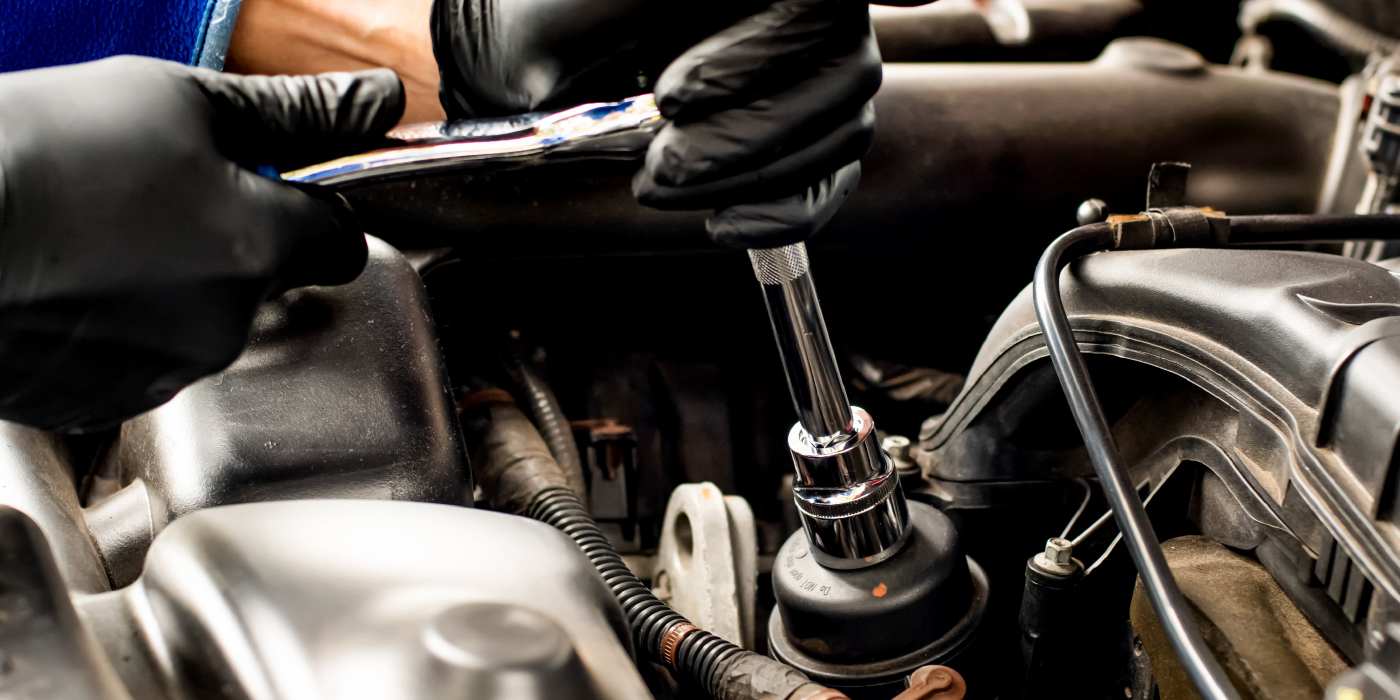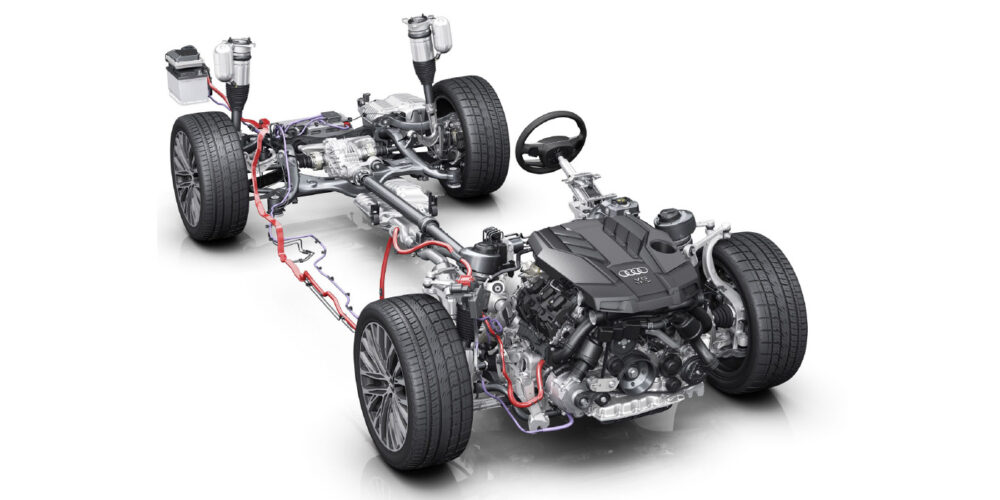ratings is the discharge load in amperes that a new 12-volt battery in a fully charged condition can deliver for 30 seconds at the specified temperature, while maintaining at least 7.2 volts at the battery terminals. CCA is the rating most generally used in the colder Northern climates.
Reserve capacity (RC) is a battery capacity rating that is making a comeback due to more key-on, engine-off accessory use. RC is the number of minutes that a 12-volt battery can supply a 25-ampere accessory draw while maintaining at least 10.5 volts at the battery terminals. CCA and RC aren’t interdependent ratings because, in some cases, a battery with a high RC rating may have fewer plates to accommodate more electrolyte capacity. More electrolyte capacity may generally produce a longer discharge time but fewer cold cranking amperes.
Amp-hour (AH) ratings generally describe the ability of deep-cycle batteries to provide a sustained discharge rate. In general, the AH rating is based on the number of amperes hours a battery can supply for 20 hours before the battery terminal voltage drops below 10.5 volts. If you’re comparing battery specifications, remember that battery suppliers often use slightly different threshold voltages to describe the RC and AH capacities of their batteries.
BATTERY LIFE
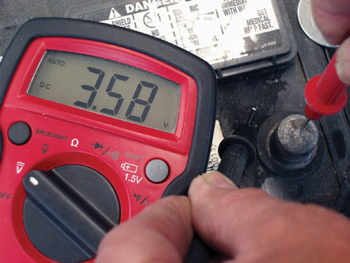 The actual service life of a battery depends upon its design and construction, and the operating conditions to which it might be exposed. Heat and vibration are the battery’s worst enemies since both tend to accelerate the normal shedding of plate material to the bottom of the battery case. In general, the average automotive battery lasts about four years before capacity and reliability become an issue.
The actual service life of a battery depends upon its design and construction, and the operating conditions to which it might be exposed. Heat and vibration are the battery’s worst enemies since both tend to accelerate the normal shedding of plate material to the bottom of the battery case. In general, the average automotive battery lasts about four years before capacity and reliability become an issue.
To reduce exposure to heat and vibration, auto manufacturers are generally careful to mount the battery in a relatively cool location in the engine compartment and to use a heat shield or “blanket” to insulate the battery against heat. In some cases, the battery is mounted inside the passenger compartment to reduce its exposure to heat and vibration.
When the battery loses a critical amount of plate capacity or when accumulated sediment shorts the positive and negative plates together, the battery fails. See Photo 1. In rare instances, batteries might also experience intermittent failures when vibration causes open circuits to develop in their plate and cell connectors.
BATTERY TESTING
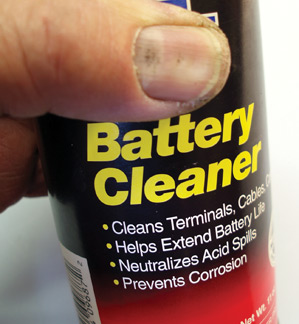 Keep in mind that lead-acid batteries are dangerous because they contain corrosive sulfuric acid and explosive hydrogen gas. For this reason, make sure a battery charger is turned off or disconnected before attaching or removing the charging leads. In cold-weather conditions, also make sure that the battery core isn’t frozen before testing or recharging.
Keep in mind that lead-acid batteries are dangerous because they contain corrosive sulfuric acid and explosive hydrogen gas. For this reason, make sure a battery charger is turned off or disconnected before attaching or removing the charging leads. In cold-weather conditions, also make sure that the battery core isn’t frozen before testing or recharging.
If acid is spilled, neutralize it with a water and baking soda solution or immediately rinse it off with plenty of water (See Photo 2). Always periodically review the safety procedures contained in your battery supplier’s catalog or training literature and wear safety glasses, gloves and acid-resistant outwear when servicing a battery.
A 12-volt automotive starting battery can be tested for its State of Health (SOH) and State of Charge (SOC) by measuring its open-circuit voltage (OCV), the specific gravity (SG) of its electrolyte, amperage discharge rate or the conductance of its cell plates. All testing and recharging must be done through clean “lead-to-lead” connections because corroded battery terminals or steel terminal adapters can generate false readings.
Before testing, the surface charge should be removed from the battery by turning on the headlamps for several minutes. After the surface charge is removed, a fully charged battery in good condition should rebound to at least 12.6 volts. While these numbers are approximate because they vary among manufacturers, an OCV between 12.6 and 12.7 volts generally indicates a 100 percent SOC, 12.4 volts a 75 percent SOC and 12.0 volts a 25 percent SOC. A battery that won’t reach at least 12.6 volts after a thorough recharge probably has a poor state of health.
TESTING SPECIFIC GRAVITY
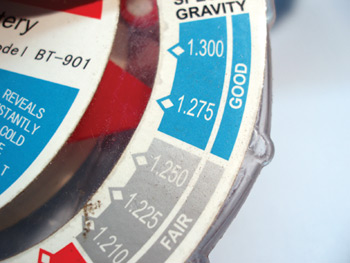 Although testing the specific gravity of the electrolyte isn’t possible on modern sealed batteries, the test can be used on batteries with removable cell caps. Most SG testers automatically compensate for electrolyte temperature and provide a “good, poor or bad” indication of cell condition. In general, the SG of a good cell should be at least 1.250 and should vary more than 0.50 gravity points from cell-to-cell. See Photo 3.
Although testing the specific gravity of the electrolyte isn’t possible on modern sealed batteries, the test can be used on batteries with removable cell caps. Most SG testers automatically compensate for electrolyte temperature and provide a “good, poor or bad” indication of cell condition. In general, the SG of a good cell should be at least 1.250 and should vary more than 0.50 gravity points from cell-to-cell. See Photo 3.
Providing no water has recently been added to the battery, the SG test is very indicative of individual cell condition. If the electrolyte is discolored, the cell plates are likely worn out. If a single battery cell is dry, it’s generally defective and water should not be added. Similarly, a battery that’s been boiled dry by overcharging is generally ruined. The corrosive electrolyte should be rinsed out of the hydrometer after each use. See Photo 4.
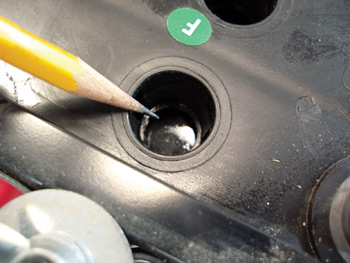 In my experience, I solved one intermittent, cold-weather, no-starting complaint on a Toyota Tacoma by testing the specific gravity of individual cells. Although the battery had passed several conductance and load tests, one cell contained pure water, which dropped the CCA and terminal voltage below Toyota’s specifications during cold cranking. Because this was a new battery, it passed the conductance and load tests simply because many new batteries exceed test specifications by at least 20 percent. If the battery has removable cell caps, I rely on a specific gravity test to solve cold-starting complaints.
In my experience, I solved one intermittent, cold-weather, no-starting complaint on a Toyota Tacoma by testing the specific gravity of individual cells. Although the battery had passed several conductance and load tests, one cell contained pure water, which dropped the CCA and terminal voltage below Toyota’s specifications during cold cranking. Because this was a new battery, it passed the conductance and load tests simply because many new batteries exceed test specifications by at least 20 percent. If the battery has removable cell caps, I rely on a specific gravity test to solve cold-starting complaints.
LOAD-TESTING
A battery must be fully charged with a core temperature of 70° F to provide an accurate amperage load test with an adjustable carbon pile load tester. A battery should be load tested at one-half the CCA rating for 15 seconds. At 70 degrees core temperature, the battery should maintain 9.6 volts at the terminals.
Last, the conductance test has become very popular because it’s fast and can test cell plate condition on badly discharged batteries. In brief, as the battery plates wear, conductance is lost. Conductance is measured by probing the battery cells with a small alternating current “ripple.” The AC ripple produces an AC voltage response that indicates the condition of the plates.
Conductance can also be used to detect shorted and open cell circuits. Most conductance testers require that CCA and the estimated battery temperature be entered. In addition, modern testers may also require that the battery type — regular, AGM or gel — be entered. In return, the conductance tester provides an estimation of the state of health and a measure of the state of charge.
SMART BATTERY CHARGERS
Many modern battery chargers contain solid-state logic that operates “smart” charging programs that quickly recharge the battery without overheating the electrolyte. To prevent damage by over-charging, most smart battery chargers also use different charging strategies and voltages for flooded, AGM and gel batteries.
Most AGM and gel-type batteries require a charger that is limited to about 14.4 to 14.6 peak charging volts. Peak charging voltage should never exceed 16 volts on a conventional flooded battery. If the battery overheats or boils without reaching peak charging voltage, the battery is likely to be defective. After recharging or servicing, it’s always good preventive maintenance to rinse the battery off with a water and baking soda solution followed by a warm water rinse.
To prevent overcharging, smart chargers may provide a “bulk charge” rate to replace about 80 percent of the battery’s depleted charge. The charger may then automatically switch to an “absorption charge” rate when the terminal voltage reaches about 14.5 volts. The charger then may taper off with a float charge of about 13.4 volts and about one ampere of current to bring the battery up to 100 percent charge. Other charges may modulate or “pulse” the charging voltage.
Regardless of the strategy, modern “smart” battery chargers are a vital necessity in this day of sophisticated battery technology.




